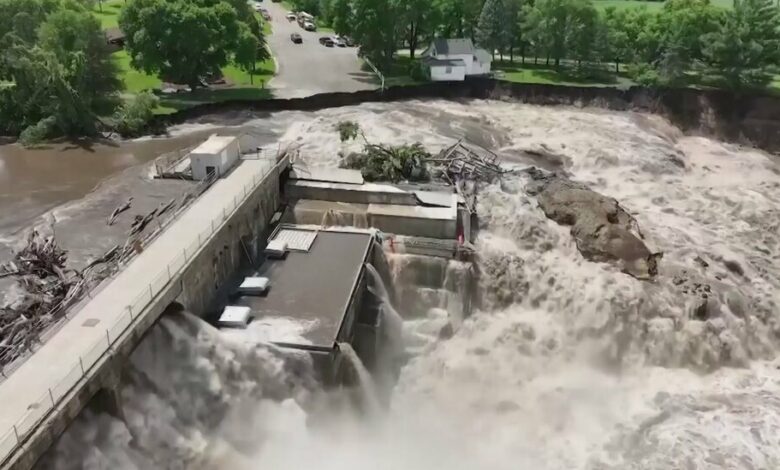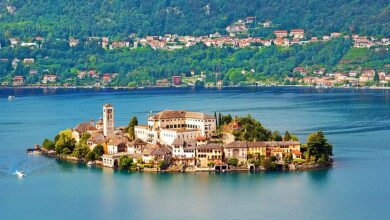How the Midwest Floods Nearly Wiped Out a Century-Old Dam

The warning from the state government was grim. The Rapidan Dam, a feature of Minnesota’s southern landscape for more than a century, was “in an imminent state of failure.”
“We don’t know if it’s going to fail completely or if it’s going to stay in place,” officials said Monday as dead trees and other debris piled up near the dam and floodwaters swept across the upper Midwest.
At one point, a support structure along the dam partially collapsed and the rushing water gouged a nearby cliff. Video footage showed a nearby building collapsing on itself and being sucked into the river. But by Tuesday, most of the dam was intact and water flows began to slow. A worst-case scenario, it seemed, could have been averted.
“The Rapidan Dam, we believe, will hold,” Bob Jacobson, the commissioner of the Minnesota Department of Public Safety, said late Tuesday afternoon after state officials flew over the dam to inspect the damage. “But there will be more reviews in the future.”
Experts said the damage and continued risk in Minnesota underscored the deteriorating state of the nation’s dams and the dangers they could pose if something went wrong. Many catastrophic floods begin with the failure of dams and breaches in states like Michigan and in recent years Nebraska have led to widespread destruction.
Climate change is making dangerous weather events more common and the average age of a US dam is approaching 60. The problems are only expected to get worse.
“It’s the perfect storm because we’re dealing with more severe extreme weather events and because these dams are getting older,” said Hiba Baroud, an associate professor of civil and environmental engineering at Vanderbilt University.
The problems at the Rapidan Dam, about 90 miles southwest of Minneapolis, came after a period of heavy rainfall that led to widespread flooding in Iowa, Minnesota and South Dakota. At least two deaths were linked to the floods, which destroyed homes, inundated farmland, overtopped dikes and collapsed a major railway bridge.
“This was, again, an unprecedented amount of rainfall that came in a very short period of time,” said South Dakota Gov. Kristi Noem. “I don’t know how many of these communities could have prepared for what they saw.”
Although river levels dropped in many of the hardest-hit areas Tuesday, some evacuations remained in effect, major roads were closed, and downstream towns were bracing for possible damage. Moderate flooding was expected in the coming days on parts of the Missouri River in Iowa and Nebraska, and major flooding was expected on parts of the Mississippi River in Iowa and Minnesota.
“We’re not out of the woods yet,” Minnesota Governor Tim Walz said. “We have not yet reached peak water levels in many of these communities,” he added, “and that will contribute to this.”
The Rapidan Dam, a 475-foot-long concrete behemoth, is a timeworn relic from another era. Completed in 1910, it became a local landmark over the generations on the Blue Earth River, which was located near a park and provided power to as many as 3,000 homes. Mr. Walz said he had been past the dam “a hundred times on my bike.”
But Rapidan’s problems were well known before this month’s flood, which surpassed the 2019 flood and became the dam’s second-worst ever.
Blue Earth County, which has managed the dam for decades, told residents on its website that “flooding and the ravages of time have caused significant damage to the structure and usability of the dam.” A federal inspection this spring noted some cracks and falling concrete but concluded that Rapidan was in “overall satisfactory condition.”
A 2021 study suggested that $15 million would be spent over four years to repair the dam, or $82 million over 10 years to remove it. Most residents who responded to a survey Two years ago there seemed to be some support for fixing it.
Rapidan’s problems are far from unique. The American Society of Civil Engineers gave the country’s 91,000-dam system a D grade in 2021, his last assessment. Because the average dam at the time was 57 years old, the organization said “the majority of dams will not have been built to current standards, let alone incorporate newer standards that improve their resilience and reduce risk to downstream areas.”
Despite these known problems, Upmanu Lall, director of the Water Institute at Arizona State University, said too little is being done.
“It costs money to remove it. It costs money to repair it,” Dr. Lall said. “We have to do one of the two. We’re not doing either.”




